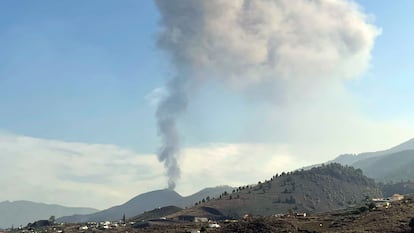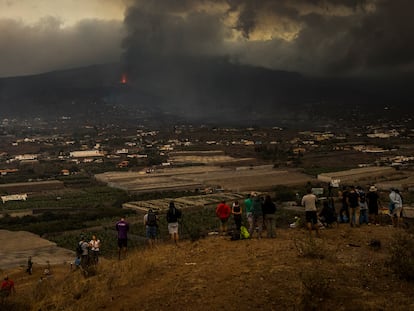Volcano on La Palma begins erupting once more after a brief pause on Monday morning
Smoke, ash and lava ceased to flow from the Canary Island for around two hours today, the ninth day of the eruption. Sunday saw the molten rock accelerate on its route toward the Atlantic Ocean


The volcano on the Canary Island of La Palma began to erupt once more on Monday, after a brief pause in activity lasting around two hours earlier in the morning. The emission of lava, smoke and ash stopped suddenly at around 8.30am local time (one hour behind Spain), after a night of constant explosions.
From the foot of the volcano, in Tajuya, there was no sign of any lava flowing from Cumbre Vieja, the area where the new volcano erupted last Sunday. By 10.30am local time, the activity had started once more.
These pauses are normal for this kind of eruption, according to sources from the National Geographic Institute (IGN), albeit it is rare for them to be so brusque. The tongues of lava that have destroyed everything in their path did not, however, halt their progress. From the port of Tazacorte, small plumes of smoke were visibly emerging from the main lava flow that destroyed much of the Todoque neighborhood.
The magma could be meeting less resistance as it emerges on the surface, or the volcano could be expelling less material
The IGN confirmed on Monday that the volcano was once again emitting “columns of smoke and gases.” Both the pause and the reactivation were “scenarios that had been accounted for” as possible, according to spokesperson Rubén López.
What’s more, the institute detected 16 earth tremors in the northern area of Fuencaliente, which lies to the south of the volcano. The most intense of these was detected at 6.05am on Monday at a depth of 10 kilometers. In general, all of them were above a magnitude of 2 on the Richter scale, and were at depths of between nine and 13 kilometers.
The increase in seismic activity, they explained from the IGN, could be due to a readjustment of the rock on which the magma feeding the volcano is located, or it could also be related to the injection of magma from other sides.
There was a fall registered this morning in the volcanic tremor, i.e. the energetic footprint of the volcano, which confirmed the fall in the activity that was being observed visually. In fact, the level of the tremor fell to the lowest point seen all week, something that can either mean that the magma is meeting less resistance as it emerges on the surface, or that the volcano is expelling less material.
“In the most recent hours, the volcanic tremor has nearly disappeared, as well as the explosive activity,” the Volcanology Institute of the Canaries (Involcan) reported on Monday. “The activity has reduced notably in the last few hours in La Palma,” explained the Madrid Geosciences Institute. “The progress must be carefully monitored because the scenario could change very fast.”
Over these eight days of eruption, other cyclic episodes that alternate between highly explosive moments and others of relative calm have been seen. Up until now, the volcano has destroyed more than 200 hectares of land and swallowed up between 500 and 600 buildings.
The increased speed with which the lava was moving on Sunday evening forced an urgent lockdown of four residential areas due to the risk of toxic gases that will be released when the lava meets the seawater. There were fears that the molten rock could have reached the ocean last night.
“Imminent” arrival at the sea
Affected residents have been instructed to stay in their homes, with the doors and windows closed until the situation can be reviewed at some point today. The lava will continue to flow until it cools sufficiently to slow its movement.
The crisis committee reported late on Sunday night that the lava flow had already passed the neighborhood of Todoque, which was evacuated several days ago, and was around 1,600 meters from the coast after crossing the LP-213 road – an essential route for access to the south of the island.
The regional premier of the Canary Islands, Ángel Víctor Torres, said on Monday that the lava from the Cumbre Vieja volcano would be arriving “imminently” at the coast.
English version by Simon Hunter.
Tu suscripción se está usando en otro dispositivo
¿Quieres añadir otro usuario a tu suscripción?
Si continúas leyendo en este dispositivo, no se podrá leer en el otro.
FlechaTu suscripción se está usando en otro dispositivo y solo puedes acceder a EL PAÍS desde un dispositivo a la vez.
Si quieres compartir tu cuenta, cambia tu suscripción a la modalidad Premium, así podrás añadir otro usuario. Cada uno accederá con su propia cuenta de email, lo que os permitirá personalizar vuestra experiencia en EL PAÍS.
¿Tienes una suscripción de empresa? Accede aquí para contratar más cuentas.
En el caso de no saber quién está usando tu cuenta, te recomendamos cambiar tu contraseña aquí.
Si decides continuar compartiendo tu cuenta, este mensaje se mostrará en tu dispositivo y en el de la otra persona que está usando tu cuenta de forma indefinida, afectando a tu experiencia de lectura. Puedes consultar aquí los términos y condiciones de la suscripción digital.
More information
Últimas noticias
Most viewed
- Reinhard Genzel, Nobel laureate in physics: ‘One-minute videos will never give you the truth’
- Oona Chaplin: ‘I told James Cameron that I was living in a treehouse and starting a permaculture project with a friend’
- Pablo Escobar’s hippos: A serious environmental problem, 40 years on
- Why we lost the habit of sleeping in two segments and how that changed our sense of time
- Charles Dubouloz, mountaineering star, retires at 36 with a farewell tour inspired by Walter Bonatti










































